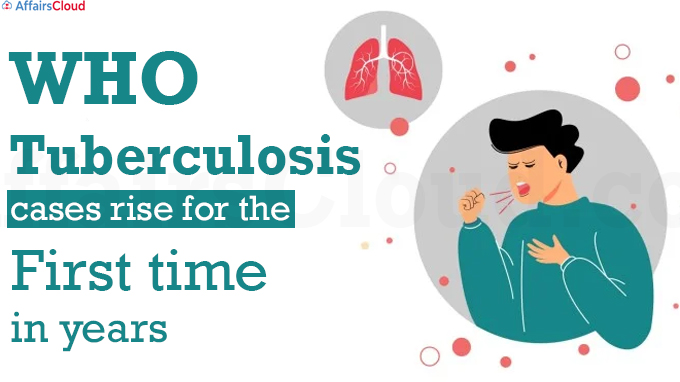
As per the Global Tuberculosis Report 2022 report issued by the World Health Organization (WHO), for the first time in year, there is rise in number of people infected with tuberculosis.
- An estimated 10.6 million people worldwide were sickened by tuberculosis in 2021, a 4.5% rise from 2020, and 1.6 million people died.
What is in the report?
The report discusses the impact of the COVID-19 pandemic on the diagnosis, treatment and burden of disease for TB all over the world. It features data on trends of disease and the response to the epidemic from 215 countries and areas, including all 194 WHO Member States.
Key Findings:
i.About 450,000 cases involved people infected with drug-resistant TB (DR-TB) in 2021, 3% more than in 2020.
ii.However, the number of people newly identified with TB fell from 7.1 million in 2019 to 5.8 million in 2020.
iii.The number of people provided with treatment for RR-TB (rifampicin-resistant TB) and multidrug-resistant TB (MDR-TB) has also declined between 2019 and 2020
- In 2021, the reported number of people started on treatment for RR-TB was 161 746, only about one in three of those in need.
iv.There is also a decline in global spending on essential TB services from US$6 billion in 2019 to US$5.4 billion in 2021.
- This is less than the global target of US$13 billion annually by 2022.
v.26.3 million people were treated for TB between 2018 and 2021 which are less than the 40 million targets set for 2018–2022.
vi.India, Nigeria, South Africa, Uganda, the United Republic of Tanzania, Zambia and Zimbabwe collectively accounted for 82% of those started on preventive treatment in 2021.
vii.Most people who develop the disease are adults. In 2021, men accounted for 56.5% of the TB burden, adult women accounted for 32.5% and children for 11%.
- Many new cases of TB are attributable to five risk factors: undernutrition, HIV (Human immunodeficiency virus) infection, alcohol use disorders, smoking and diabetes.
7 countries with the Highest Burden of MDR/RR-TB cases in 2021
The seven countries with the highest burden of MDR/RR-TB cases in 2021 are India with estimated case range of 93,000 – 1,45,000; Russia (31,000 – 46,000); Pakistan (6,200 – 65,000); China (27,000 – 39,000); Indonesia (15,000 – 41,000), South Africa (13,000 – 29,000), and Phillippines (8,300 – 34, 000).
- It should be noted that India is the only country to have completed National Prevalence Survey in 2021.
India reports 2.14 mn new TB cases in 2021; 18% higher than previous year
India notified 21.4 lakh TB cases in 2021 which is approx. 18% higher than 2020. India at the 36th position in terms of incidence rates (from largest to smallest incidence numbers).
Metrices on which India performed better:
i.India’s TB incidence for 2021 is 210 per 100,000 population as compared to the baseline year of 2015 when it was 256 per lakh of population in India.
ii.There has been an 18% decline which is 7 percentage points better than the global average of 11%.
iii.The National TB Elimination Programme notified over 21.4 lakh TB cases, 18% higher than 2020.
iv.In 2021, over 22 crore people were screened for TB through the government intensified door-to-door active case finding drives.
v.Under the Pradhan Mantri TB Mukt Bharat Abhiyan, an initiative of the government, more than 40,000 Nikshay Mitra are supporting over 10.45 lakh TB patients across India.
vi.During 2020-21, India made cash transfers of 89 million dollars (INR 670 crores) to TB patients through a Direct Benefit Transfer programme.
The Central TB Division (CTD) of Ministry of Health & Family Welfare (MoH&FW) initiated domestic studies for more accurate estimate of incidence and mortality rates of TB in a systematic manner. The results for the same will be available in approximately six months’
Points to be noted:
i.After COVID-19, TB is the world’s deadliest infectious contagious disease. It is preventable and curable.
ii.TB is caused by bacteria (Mycobacterium tuberculosis) that most often affect the lungs. iii.30 countries with highest burden of TB are. These include: Angola, Bangladesh, Brazil, Central African Republic, China, Congo, Democratic People’s Republic of Korea, Democratic Republic of Congo, Ethiopia, Gabon, India, Indonesia, Kenya, Lesotho, Liberia, Mongolia, Mozambique, Myanmar, Namibia, Nigeria, Pakistan, Papua New Guinea, Philippines, Sierra Leone, South Africa, Thailand, Uganda, United Republic of Tanzania, Viet Nam and Zambia.
Recent Related News:
i.The Joint United Nations Programme on HIV/AIDS (UNAIDS), United Nations Children’s Fund (UNICEF), World Health Organization (WHO), and partners have joined forces to form the global alliance in order to guarantee that no child living with HIV is denied treatment by the end 2030.
ii.According to the WHO, almost entire world’s population (99%) breathes air that exceeds the WHO air quality limit.
About World Health Organization (WHO):
Director-General– Dr Tedros Adhanom Ghebreyesus of Ethiopia.
Headquartered– Geneva, Switzerland
Establishment– 1948



